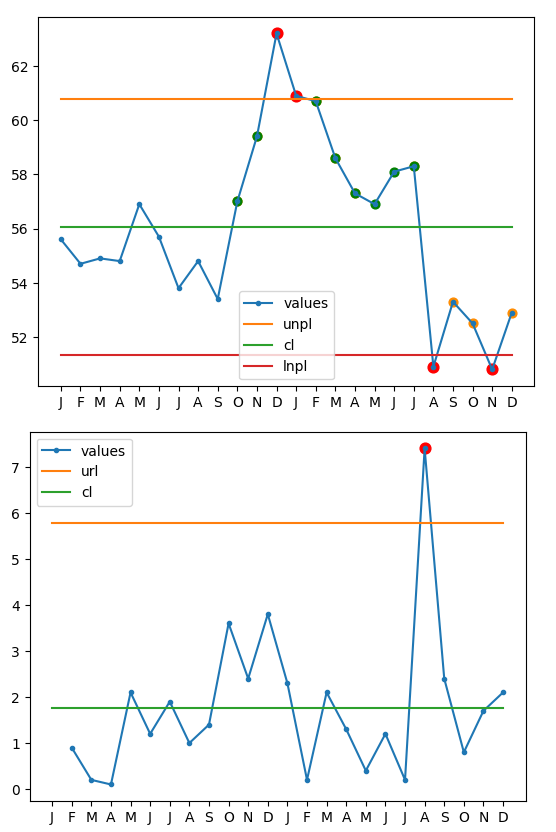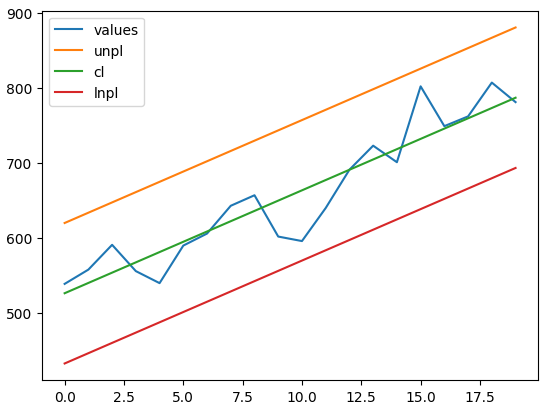A Python helper library for generating Process Behaviour Charts
Project description
statprocon
statprocon is a Python helper library for generating data for use in Statistical Process Control charts. SPC charts are also known as Process Behaviour Charts, Control charts or Shewhart charts.
SPC Charts help answer questions like:
- How do I know a change has occurred in a process?
- What is the expected variation in a process?
- Is a process stable or unpredictable?
Installation
pip install statprocon
Usage
from statprocon import XmR
counts = [10, 50, 40, 30]
xmr = XmR(counts)
moving_ranges = xmr.moving_ranges()
unpl = xmr.upper_natural_process_limit()[0] # 85.7
lnpl = xmr.lower_natural_process_limit()[0] # -20.7
x_cl = xmr.x_central_line()[0] # 32.5
url = xmr.upper_range_limit()[0] # 65.36
mr_cl = xmr.mr_central_line()[0] # 20
Currently, this library only supports the data for generating an XmR chart. An XmR chart is the most universal way of using process behaviour charts. XmR is short for individual values (X) and a moving range (mR). More chart data options can be added via pull requests.
For more information, please read Making Sense of Data by Donald Wheeler.
pandas
Visualize XmR charts using Jupyter Notebooks and pandas
import pandas as pd
from statprocon import XmR
xmr = XmR(counts)
pd.DataFrame(xmr.x_to_dict()).astype(float).plot()
pd.DataFrame(xmr.mr_to_dict()).astype(float).plot()
Charts can display X-axis labels by using the following code:
labels = [...]
pd.DataFrame(xmr.x_to_dict(), index=labels).astype(float).plot()
Or use built-in methods to generate charts that highlight detection points:
import pandas as pd
labels = [...]
xmr = XmR(counts)
xmr.x_plot(pd, labels)
xmr.mr_plot(pd, labels)
Data points that meet detection rules are marked by the following colours:
| Rule | Colour |
|---|---|
| Rule 1 | Red |
| Rule 2 | Green |
| Rule 3 | Orange |
If one data point meets the criteria for multiple detection rules, the lower numbered detection rule will take priority and be marked. For example, if a data point meets all detection rules, it will be displayed in red. If a data point meets rule 2 and rule 3, it will be displayed in green.
CSV
Generate a CSV of all the data needed to create XmR charts.
print(xmr.to_csv())
Google Sheets Charts
Generate XmR Charts in Google Sheets
https://github.com/mattmccormick/statprocon/assets/436801/0de1a9f3-a8ad-4047-8c9d-0f890e0bf453
- Make a copy of the statprocon XmR Template sheet
- Paste the CSV output from above into cell A1
- Click
Data -> Split Text to Columns
The X and MR charts will appear on the right.
Note that the Lower Natural Process Limit may not make sense if your count data could not possibly go negative. If LNPL is not needed, remove it with the following steps:
- Double-click on the X Chart
- Click the
Setuptab - Under
Series, findLNPL - Click the 3 dot menu on the right next to
LNPL - Click
Remove
The LNPL line will be removed from the X Chart.
Advanced Usage
Halfway Lines
Halfway lines between the X central line and the Upper and Lower Natural Process Limits can be returned by using the include_halfway_lines argument:
xmr.x_to_dict(include_halfway_lines=True)
When the process is predictable, approximately 85% of the X values fall between the Upper and Lower halfway lines.
Trending Limits
With data points that trend upwards or downwards over time, use Trending Limits to calculate a sloping X central line, Upper Natural Process Limits and Lower Natural Process Limits.
from statprocon import XmRTrending
counts = [...] # data from TrendingTestCase.test_trending_limits
source = XmR(counts)
trending = XmRTrending(source)
pd.DataFrame(trending.x_to_dict()).astype(float).plot()
Use the Median Moving Range
If your data contains extreme outliers, it may be better to compute the limits using the median moving range.
xmr = XmR(counts, moving_range_uses='median')
Use the Median for the X Central Line
xmr = XmR(counts, x_central_line_uses='median')
Note: It's assumed that by using the median for the X central line that the median moving range should also be used. For example, you cannot do the following:
xmr = XmR(counts, x_central_line_uses='median', moving_range_uses='average')
Calculate Limits from Subset of Counts
The central lines and limits calculations can be restricted to a subset of the count data.
Use the subset_start_index and subset_end_index parameters when instantiating the XmR object:
xmr = XmR(counts, subset_start_index=10, subset_end_index=34) # 24 points of data starting at index 10
When one or both of these optional arguments are provided, the the X and MR central line calculations will be modified to only use the data from subset_start_index up to, but not including, subset_end_index.
When these optional arguments are not provided, subset_start_index defaults to 0 and subset_end_index defaults to the length of counts.
Dependencies
There are a few other Python libraries for generating SPC charts but they all contain large dependencies in order to include the ability to graph the chart. This package will remain small and light and not require large dependencies. The user will need to convert the data into charts on their own.
This package also contains extensive tests for verifying the integrity of the calculated data.
Development
Create virtualenv
python3 -m venv venv
Activate virtualenv
source venv/bin/activate
python -m build
python -m twine upload dist/*
Testing
python3 -m pip install .
Run tests
tox
Project details
Release history Release notifications | RSS feed
Download files
Download the file for your platform. If you're not sure which to choose, learn more about installing packages.
Source Distribution
Built Distribution
Hashes for statprocon-1.0.0-py3-none-any.whl
| Algorithm | Hash digest | |
|---|---|---|
| SHA256 | 33dfac26aa2b10b9d993fea42b19ed63680e8af58986442bc654478fe2c2681d |
|
| MD5 | ea66bab0190d12ff1eb9b8ea88066941 |
|
| BLAKE2b-256 | 261464c1240cdee56c7ba44c19f0b3d345ec5eaf9590f8b9d5c2080d3eb65ac0 |














